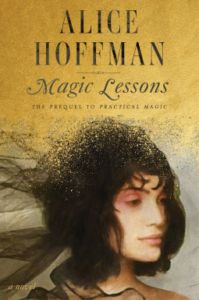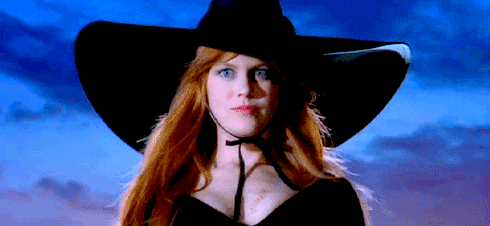Magic Lessons
The Prequel to Practical Magic
By Alice Hoffman
Simon & Schuster
Pub date: 06-Oct-2020
AMBER LOVE 21-JULY-2020 This review is a courtesy provided by NetGalley. To support this site and my other work, please consider being a monthly donor at Patreon.com/amberunmasked; you can also buy my books through Amazon (or ask your local retailer to order you copies). I’m also an Amazon Influencer so you can shop through my lists of recommended products.
Publisher’s summary:
In an unforgettable novel that traces a centuries-old curse to its source, beloved author Alice Hoffman unveils the story of Maria Owens, accused of witchcraft in Salem, and matriarch of a line of the amazing Owens women and men featured in Practical Magic and The Rules of Magic.
Where does the story of the Owens bloodline begin? With Maria Owens, in the 1600s, when she’s abandoned in a snowy field in rural England as a baby. Under the care of Hannah Owens, Maria learns about the “Unnamed Arts.” Hannah recognizes that Maria has a gift and she teaches the girl all she knows. It is here that she learns her first important lesson: Always love someone who will love you back.
When Maria is abandoned by the man who has declared his love for her, she follows him to Salem, Massachusetts. Here she invokes the curse that will haunt her family. And it’s here that she learns the rules of magic and the lesson that she will carry with her for the rest of her life. Love is the only thing that matters.
Magic Lessons is a celebration of life and love and a showcase of Alice Hoffman’s masterful storytelling.
Review:
Let me begin by saying that I am a huge fan of the Practical Magic movie, but have never read Alice Hoffman’s book. People always told me that the movie was better. After reading Magic Lessons, I have a difficult time believing that. Magic Lessons is robust! It’s summarized as Maria Owens’ story, but in truth there are four women central to this 416-page historical fiction. As a reviewer of an advanced copy, the text isn’t officially considered finalized so they aren’t supposed to be quoted; however, I love great quotes and do use them from ARCs often. I have a ton of passages highlighted in Magic Lessons and I have to include a few knowing they may not be the actual published words.
Hoffman didn’t use traditional chapters in the layout of Magic Lessons. There are multiple parts broken up by section dividers. Within the sections, Hoffman includes Hannah’s and Maria’s lists of remedies and garden tips. Fans of the Practical Magic movie would have heard such tips as always plant lavender for luck and keep rosemary by your garden gate. It’s the last part which the movie and the book get to that makes a heartwarming mention by the end of Magic Lessons: fall in love whenever you can.
It felt derailed at times only because this book is just as much two books as one. Maria’s daughter Faith gets a substantial story taking up her own share of pages. Faith’s story goes from her birth to age sixteen. Maria’s story goes from her birth (including her birth mother Rebecca and her adoptive mother Hannah) into adulthood. The story takes place from 1664 – 1696.
It’s Hannah’s lessons on the Nameless Art (witchcraft) that are key to everything Maria learns. There’s plenty of Anglo and North American settings with culturally-specific fairy tale imagery. Maria goes from Essex County in England to the Caribbean to the Massachusetts Bay Colony to New York City (where the Dutch still have the majority of influence). From one Essex County to another (England to Massachusetts), Maria faces constant double-edged swords as all in the Nameless Art do. On one hand, women seek their services; on the other hand, those women belong to religions, families, or strict societies where witches are to be persecuted.
Each character feels genuinely alive with ample time to get to know who they are and what motivations drive them. Rebecca abandoned Maria at birth, but it was probably the right thing to do because Hannah (also a blood lineage witch) was the one to find her. Hannah was far more maternal than Rebecca’s selfish ambitions driven by lust. Readers probably won’t come out hating or even disliking Rebecca though despite her choices being made by her love of an actor rather than her abusive husband. Rebecca had to do whatever possible to find her own sense of empowerment and ultimately freedom. A child was not something she was willing to take on at the time of Maria’s birth given the family circumstances. Maria gets to know her for a while and she learns plenty including how love is the most powerful force.
Love backfires for Hannah too, but it’s told in past tense. The love of her life betrayed her and Hannah never loved another person. When she finds this baby in the snow with a witch’s mark, her life is as full as she needs it be. Hannah is the ultimate parent in every way. Her love is carried through Maria on the child’s unbelievably oppressive quest halfway around the world. It’s also mentioned that Hannah’s form of green magic which is based on the natural world more than worship of a deity comes from Old Norse tradition and was brought to England.
Maria is the type of character who is different in the way her strength comes out; and her own child Faith is remarkably different from her mother’s as well. Examining the trauma of each female character (all witches trying to survive in secret), readers can see how the human body, mind, and environment play parts in choices. Rebecca’s answer is to flee. Hannah’s is that of a warrior willing to make every sacrifice for the love of her daughter. Maria disobeys those in power over her and learns to be mature in decision-making in adolescence. Faith pretends to obey all her oppressors, but then seeks revenge. Fighting, fleeing, dissociating under duress, and seeking to do harm. Those are ways Hoffman brilliantly shows her skills in character arcs. Readers will undoubtedly wonder who gets redeemed and who doesn’t until the end.
Since this is historical fiction, the setting of the Salem Witch Trials plays one of the key parts. John Hathorne, an angry, conservative, Puritan magistrate is one of the book’s central male figures. Other known historical figures are mentioned like Increase and Cotton Mather and Governor Phipps. What you need to know about John Hathorne can be summed up in this quote (*may not be the published version):
Women could destroy men, he was sure of it, as Eve had tempted Adam. This was the reason women were not allowed to speak in church. To merely look up on them could cause vile thoughts, and soon enough such thoughts could become deeds. Hathorne believed that God and his angels moved through the mortal world, but the devil walked among them as well.
The shift in Hathorne from the man Maria met and fell in love with to his true self as a stubborn, self-righteous magistrate in New England is the form of masculinity off-set by the beauty and purity of “bad boys” found in sailors/pirates/importers Samuel Dias and his father Abraham. The Dias men were also forced to leave their home due to religious persecution. Samuel is at least more age appropriate than most of the other relationships mentioned for the Owens women. John Hathorne is thirty-seven when he meets fifteen-year-old Maria.
Without spoiling too much, the animal familiars are characters as fully formed as any human ones. They have journeys and Hoffman includes reminders that a familiar comes to a witch by choice and can leave whenever it wants to. It’s not a subservient being as depicted in many stories. The familiar forms a bond with their witch as strong as a best friend, parent, or sibling. Familiars are family. They also have their own agency showing that their loyalty is not unconditional. They try to guide their human companions as best as they can. They try to protect each other as partners.
For protection against love: black cloth, red thread, clove, blackthorn.
As expected for a book about magic and folklore, there is a ton of symbolism in Hoffman’s choices. Blue is the color of protection in her version of magic. Typically today’s practicing witches use black for protection, but black is for mourning. Grey is the color of the oppressed who dared not have any personal expression at all. It also represents depression and sadness. Red is downright scandalous among the people in the Massachusetts Bay Colony but it probably wouldn’t be noticed as clothing in Curaçao. Red hair was considered a sign of a witch or someone not to be trusted. The witches love to wear their red boots and blue dresses. Candles for love spells — to bring it or send it away — are white. Blood magic is a whole different world than sympathetic magic.
Black magic, red magic, blood magic, love magic. Rebecca divided both the world that she walked through and the world that was unseen into these categories.
I also want to give Hoffman recognition for always including the indigenous origins of spell ingredients, rituals, and methods that go into magic performed by Maria and Faith. The women who are enslaved have their own magic and Hoffman emphasizes that Maria cannot simply lurk and borrow their ways. She has to wait for an invitation and proper lessons from her friend’s aunt during her time in Curaçao. Faith ends up with The Book of the Raven written by an enslaved woman from Africa. The book somehow ended up in New York for sale at a market vendor. The desperation of those women called for revenge magic and Faith ends up on that path, the left-hand path as some would call it. The choices in the unseen women of Magic Lessons is relevant today in the Black Lives Matter and other civil rights movements. The target audience of this book might not be women of color, but they have roles to play. In Curaçao, one of the housemaids, Juni, becomes like a sister to Maria. Juni’s contract as a black girl is different than Maria’s contract of indentured servitude. Using what little privilege Maria has, she leverages it to get Juni’s freedom too.
Rating: 5 stars



1 Comment on Book review: #MagicLessons by Alice Hoffman #netgalley
Comments are closed.